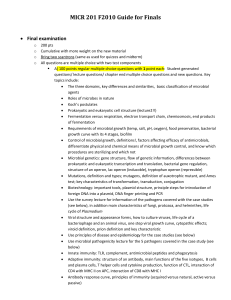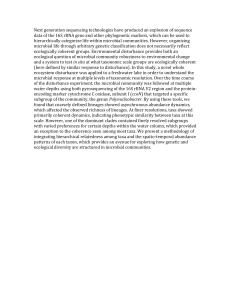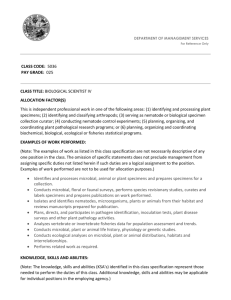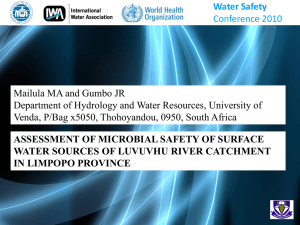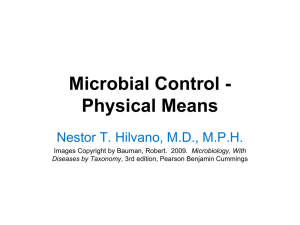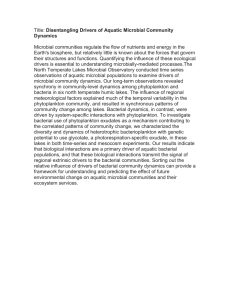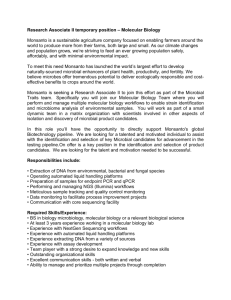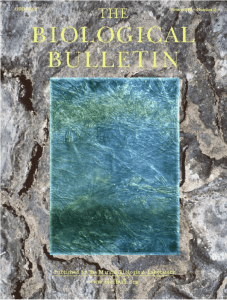Biodiversity and Geochemical Cycles and Diversity in Microbial Mats
advertisement
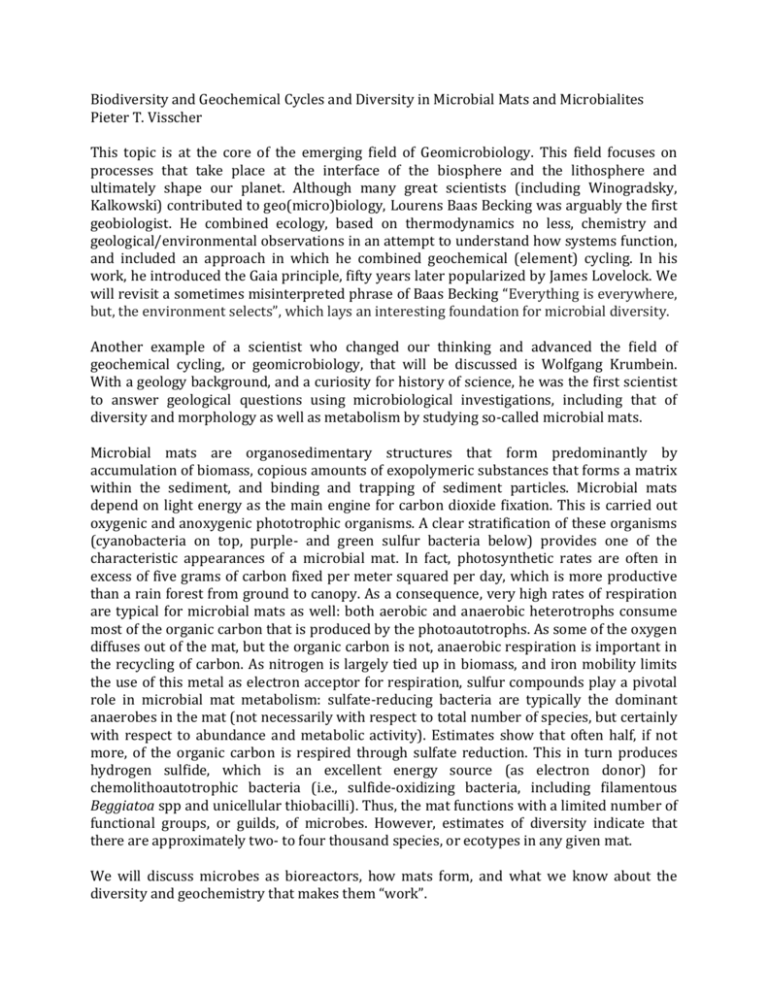
Biodiversity and Geochemical Cycles and Diversity in Microbial Mats and Microbialites Pieter T. Visscher This topic is at the core of the emerging field of Geomicrobiology. This field focuses on processes that take place at the interface of the biosphere and the lithosphere and ultimately shape our planet. Although many great scientists (including Winogradsky, Kalkowski) contributed to geo(micro)biology, Lourens Baas Becking was arguably the first geobiologist. He combined ecology, based on thermodynamics no less, chemistry and geological/environmental observations in an attempt to understand how systems function, and included an approach in which he combined geochemical (element) cycling. In his work, he introduced the Gaia principle, fifty years later popularized by James Lovelock. We will revisit a sometimes misinterpreted phrase of Baas Becking “Everything is everywhere, but, the environment selects”, which lays an interesting foundation for microbial diversity. Another example of a scientist who changed our thinking and advanced the field of geochemical cycling, or geomicrobiology, that will be discussed is Wolfgang Krumbein. With a geology background, and a curiosity for history of science, he was the first scientist to answer geological questions using microbiological investigations, including that of diversity and morphology as well as metabolism by studying so-called microbial mats. Microbial mats are organosedimentary structures that form predominantly by accumulation of biomass, copious amounts of exopolymeric substances that forms a matrix within the sediment, and binding and trapping of sediment particles. Microbial mats depend on light energy as the main engine for carbon dioxide fixation. This is carried out oxygenic and anoxygenic phototrophic organisms. A clear stratification of these organisms (cyanobacteria on top, purple- and green sulfur bacteria below) provides one of the characteristic appearances of a microbial mat. In fact, photosynthetic rates are often in excess of five grams of carbon fixed per meter squared per day, which is more productive than a rain forest from ground to canopy. As a consequence, very high rates of respiration are typical for microbial mats as well: both aerobic and anaerobic heterotrophs consume most of the organic carbon that is produced by the photoautotrophs. As some of the oxygen diffuses out of the mat, but the organic carbon is not, anaerobic respiration is important in the recycling of carbon. As nitrogen is largely tied up in biomass, and iron mobility limits the use of this metal as electron acceptor for respiration, sulfur compounds play a pivotal role in microbial mat metabolism: sulfate-reducing bacteria are typically the dominant anaerobes in the mat (not necessarily with respect to total number of species, but certainly with respect to abundance and metabolic activity). Estimates show that often half, if not more, of the organic carbon is respired through sulfate reduction. This in turn produces hydrogen sulfide, which is an excellent energy source (as electron donor) for chemolithoautotrophic bacteria (i.e., sulfide-oxidizing bacteria, including filamentous Beggiatoa spp and unicellular thiobacilli). Thus, the mat functions with a limited number of functional groups, or guilds, of microbes. However, estimates of diversity indicate that there are approximately two- to four thousand species, or ecotypes in any given mat. We will discuss microbes as bioreactors, how mats form, and what we know about the diversity and geochemistry that makes them “work”. Interactions between Microbes and Minerals in Microbial Mats and Stromatolites Pieter T. Visscher In this lecture, we will discuss the processes by which microbial mats lithify, i.e., how they turn into microbialites. The various processes of organomineralization will be reviewed. Microbial mats are organosedimentary biofilms that greatly impacted the geochemical and physicochemical conditions on Earth through geological time. These laminated ecosystems are formed by through geomicrobiological processes, including biomass production, binding and trapping of sediments, and mineral precipitation. Lithified mats, or microbialites date back over 3 billion years in the rock record. The interpretation of fossil microbial mats in the rock record and, consecutively, assessment of their potential role in the alteration of Earth’s geochemical environment through time is hampered by the poor preservation of these organic-rich structures. The preservation potential, however, can be enhanced through microbially-mediated lithification. The three key components of microbially-mediated mineral precipitation are: 1) the "alkalinity" engine (i.e., microbial community metabolism and environmental conditions impacting the calcium (or magnesium) carbonate saturation index); 2) the complex organic matrix comprised of exopolymeric substances (EPS); and 3) the coordination of community physiologies and sensing of environmental conditions (e.g., pH, oxygen concentration) through chemical communication, or quorum sensing. These combined geochemical-microbial activities provide conditions that allow specific microbialites to form, both on a macroscale (i.e., morphology) as well as on a microscale (i.e., shape and composition of minerals) While mineral shape and composition may be a function of the EPS properties and therefore has the potential to reflect a specific signature of the microbial community, it is unresolved how, for example, continuous laminae vs. clotted fabrics form. The cyanobacterial community, situated near the surface according to the ambient light conditions, provides the organic carbon for heterotrophs. All these respiring organisms (including “strict” anaerobes, such as sulfate-reducing bacteria and methanogens) display their maximum metabolic activity along a surface horizon that may lithify. Some ideas emerge how chemical communication may play a role in this, and how microbial signaling compounds may be used to detect specific environmental conditions and may allow synchronizing of intra- and interspecies metabolic activities. These recent observations and ideas are, however, merely a first step in the understanding of microbialite formation, and their potential to weather the diagenetic processes so that some of the biological signatures are preserved. In addition to discussing the three ingredients of lithification outlined above, we will review some examples of microbialite formation in hypersaline lakes, and in open marine and/or hypersaline systems (Highborne Cay, Bahamas and Shark Bay, Australia, respectively). A brief comparison of stromatolites and thrombolites will also be introduced.
